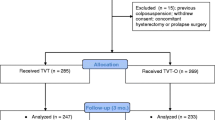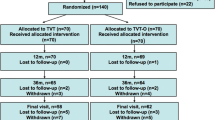Abstract
This study examines the safety of the inside-out transobturator approach for transvaginal tape (TVT-O™, Gynaecare) treatment in stress urinary incontinence (SUI) in women based on a French registry of patients. A total of 984 women from 86 centres were enrolled in the study. Patients with predominant overactive bladder or significant pelvic organ prolapse were excluded from the study. Perioperative and post-operative complications were reported as well as urinary function at 4 and 12 weeks. Pain was assessed by the patients using a visual analog scale (VAS). The overall perioperative complication rate was 2.2%. The most commonly reported morbidities were vaginal wall perforation (1.3%) followed by haematoma (0.7%). Post-operative complication rate was 5.2%; the most common complication was residual pain (2.7%). The other complications of paravesical haematoma, urinary retention, vaginal erosion and re-intervention had an incidence of less than 1.0%. This study demonstrates that the transobturator transvaginal tape approach to the treatment of SUI is a safe procedure.
Similar content being viewed by others
References
Blaivas JG, Appell RA, Fantl JA et al (1997) Standards of efficacy for evaluation of treatment outcomes in urinary incontinence: recommendations of the urodynamics society. Neurourol Urodyn 16:145–147
Blaivas JG (1998) Outcome measures for urinary incontinence. Urology 51(2A Suppl):11–19
O’Donnell P (1994) Goals of therapy and mechanisms of urethral incontinence. In: McGuire EJ, Kursh ED (eds) Female urology. Lippincott, Philadelphia, pp 175–201
Bezerra CA, Bruschini H, Cody DJ (2005) Suburethral sling operations for urinary incontinence in women. The Cochrane Collaboration. Wiley, London
Boustead GB (2002) The tension-free vaginal tape for treating female stress urinary incontinence. BJU Int 89(7):687–693
Delorme E (2001) Transobturator urethral suspension: mini-invasive procedure in the treatment of stress urinary incontinence in women. Prog Urol 11(6):1306–1313
Hermieu JF, Messas A, Delmas V et al (2003) Bladder injury after TVT transobturator. Prog Urol 13(1):115–117
Delmas V (2005) Anatomical risks of transobturator suburethral tape in the treatment of female stress urinary incontinence. Eur Urol 48(5):793–798
de Leval J (2003) Novel surgical technique for the treatment of female stress urinary incontinence: transobturator vaginal tape inside-out. Eur Urol 44(6):724–730
Giberti C, Gallo F, Cortese P, Schenone M (2007) Transobturator tape for treatment of female stress urinary incontinence: objective and subjective results after a mean follow-up of two years. Urology 69(4):703–707
Latthe PM, Foon R, Toozs-Hobson P (2007) Transobturator and retropubic tape procedures in stress urinary incontinence: a systematic review and meta-analysis of effectiveness and complications. BJOG 114(5):522–531
Tamussino KF, Hanzal E, Kölle D, Ralph G, Riss PA, Austrian Urogynecology Working Group (2001) Tension-free vaginal tape operation: results of the Austrian registry. Obstet Gynecol 98(5 Pt 1):732–736
Schraffordt Koops SE, Bisseling TM, Heintz AP, Vervest HA (2006) The effectiveness of tension-free vaginal tape (TVT) and quality of life measured in women with previous urogynecologic surgery: analysis from The Netherlands TVT database. Am J Obstet Gynecol 195(2):439–444
Kuuva N, Nilsson CG (2002) A nationwide analysis of complications associated with the tension-free vaginal tape (TVT) procedure. Acta Obstet Gynecol Scand 81(1):72–77
Costa P, Grise P, Droupy S et al (2004) Surgical treatment of female stress urinary incontinence with a trans-obturator-tape (T.O.T.) Uratape: short term results of a prospective multicentric study. Eur Urol 46(1):102–106
Delorme E, Droupy S, de Tayrac R, Delmas V (2004) Transobturator tape (Uratape): a new minimally-invasive procedure to treat female urinary incontinence. Eur Urol 45(2):203–207
Grise P, Droupy S, Saussine C et al (2006) Transobturator tape sling for female stress incontinence with polypropylene tape and outside-in procedure: prospective study with 1 year of minimal follow-up and review of transobturator tape sling. Urology 68(4):759–763
Neuman M (2007) TVT and TVT-Obturator. Comparison of two operative procedures. Eur J Obstet Gynecol Reprod Biol 131(1):89–92
Liapis A, Bakas P, Giner M, Creatsas G (2006) Tension-free vaginal tape versus tension-free vaginal tape obturator in women with stress urinary incontinence. Gynecol Obstet Invest 62(3):160–164
Debodinance P (2006) Trans-obturator urethral sling for surgical correction of female stress urinary incontinence: outside-in (Monarc) versus inside-out (TVT-O). Are both ways safe? J Gynecol Obstet Biol Reprod (Paris) 35(6):571–577
Waltregny D, Reul O, Mathantu B, Gaspar Y, Bonnet P, de Leval J (2006) Inside out transobturator vaginal tape for the treatment of female stress urinary incontinence: interim results of a prospective study after a 1-year minimum follow-up. J Urol 175(6):2191–2195
deTayrac R, Deffieux X, Droupy S, Chauveaud-Lambling A, Calvanese-Benamour L, Fernandez H (2004) A prospective randomized trial comparing tension-free vaginal tape and transobturator suburethral tape for surgical treatment of stress urinary incontinence. Am J Obstet Gynecol 190(3):602–608
Ward KL, Hilton P (2004) A prospective multicenter randomized trial of tension-free vaginal tape and colposuspension for primary urodynamic stress incontinence: two-year follow-up. Am J Obstet Gynecol 190:324–331
Ulmsten U, Hendriksson L, Johnsson P et al (1996) An ambulatory surgical procedure under local anesthesia for treatment of female urinary continence. Int Urogynecol J 7:81–86
Wang AC, Lo TS (1998) Tension-free vaginal tape. A minimally invasive solution to stress urinary continence in women. J Reprod Med 43:429–434
Sergent F, Popovic I, Grise P, Leroi AM, Marpeau L (2006) Three-year outcomes of the tension-free vaginal tape procedure for treatment of female stress urinary incontinence with low urethral closure pressure. Gynecol Obstet Fertil 34(9):692–700
Acknowledgements
Johnson & Johnson, France provided support for the electronic database and investigator meetings. All data analyses were independent of Johnson & Johnson.
Conflicts of interest
None.
Author information
Authors and Affiliations
Corresponding author
Rights and permissions
About this article
Cite this article
Collinet, P., Ciofu, C., Costa, P. et al. The safety of the inside-out transobturator approach for transvaginal tape (TVT-O) treatment in stress urinary incontinence: French registry data on 984 women. Int Urogynecol J 19, 711–715 (2008). https://doi.org/10.1007/s00192-007-0514-6
Received:
Accepted:
Published:
Issue Date:
DOI: https://doi.org/10.1007/s00192-007-0514-6




